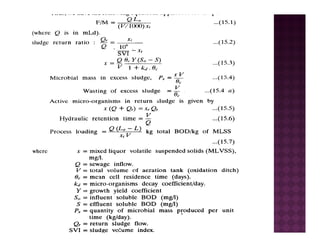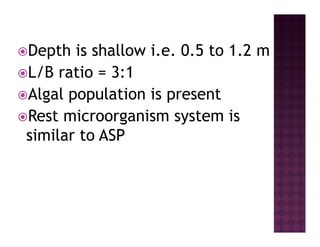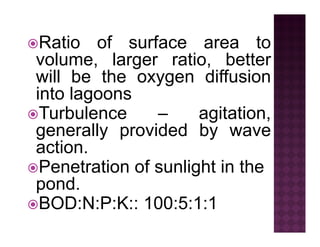Miscelleaneous methods
- 1. UNIT – III Environmental Engineering – IIEnvironmental Engineering – II Prof S S JAHAGIRDAR BE (CIVIL), ME(ENV.)PhD(persuing) NK Orchid college of Engg. and Tech.NK Orchid college of Engg. and Tech. Solapur
- 2. A Oxidation ditchA. Oxidation ditch B Oxidation pondsB. Oxidation ponds C. Aerated lagoonsg D. Septic tanks (Already covered for two batches during practical hrs)
- 3. Essentially an extended aeration activated sludge processg p Consists of endless ditches for the aeration tank and a rotor for aerationaeration tank and a rotor for aeration mechanism. N PST i d dNo PST is needed. Rotors designed to impart 0.3 to 0.4g p m/s velocity. Rotors have dia = 70 cm and speed =Rotors have dia. = 70 cm and speed = 75 rpm
- 4. Rotors are manufactured in 30 cm intervals up to 4.5 m length.p g The width of ditch divided by the rotor length ratio= 1.5 to 2.8.length ratio 1.5 to 2.8. Standard oxygen transfer capacity of rotor = 2 8 kg of oxygen / m length @ 16 cm depth of2.8 kg of oxygen / m length @ 16 cm depth of immersion. This rotor has been found to impartThis rotor has been found to impart adequate circulation for 120 to 150 cu.m. of ditch volumeditch volume. Power requirement/m length of rotor = 1.35 kWkW Depth = 1 to 1.2 m
- 8. Is an open, flow throughp , g earthen basin of controlled shape specifically designedshape, specifically designed and constructed to treat sewage and biodegradablesewage and biodegradable industrial wastes. Mixing by natural means (No artificial oxygen supply)yg pp y)
- 12. D th i h ll i 0 5 t 1 2Depth is shallow i.e. 0.5 to 1.2 m L/B ratio = 3:1L/B ratio 3:1 Algal population is present Rest microorganism system is similar to ASPsimilar to ASP
- 13. Ratio of surface area toRatio of surface area to volume, larger ratio, better will be the oxygen diffusionwill be the oxygen diffusion into lagoons T b l it tiTurbulence – agitation, generally provided by waveg y p y action. Penetration of sunlight in thePenetration of sunlight in the pond. BOD:N:P:K:: 100:5:1:1BOD:N:P:K:: 100:5:1:1
- 14. Anaerobic decomposition takesAnaerobic decomposition takes place in two steps, Decomposition of organic wasteDecomposition of organic waste, by acid producing bacteria to organic acids andorganic acids and Further decomposition of these acids to the end products ofacids to the end products of methane, carbon dioxide and water by methane formerswater by methane formers.
- 15. Less surface area than aerobic ponds. Depth ranges from 2.5 to 5 m. L/B ratio = 2:1 Summer season - BOD loading = 1000 to 2000 kg/ha/day with detentions ofg y 2 to 5 days. Efficiency of BOD removal is @ 65 toEfficiency of BOD removal is @ 65 to 80 % Winter season - BOD loading = 500 toWinter season - BOD loading = 500 to 1000 kg/ha/day with Efficiency of BOD removal @ 45 to 65 %BOD removal @ 45 to 65 %
- 16. Organic loading is @ 10 timesOrganic loading is @ 10 times more than aerobic pond. Optimum pH range is 6.6 to 7.6
- 17. Combined features of aerobic andCombined features of aerobic and anaerobic ponds. D h 1 1 5Depth =1 to 1.5 m Aerobic zone at topp Anaerobic at bottom Fac ltati e bet een abo e t oFacultative between above two zones.
- 20. Intermediate systemIntermediate system between oxidation ponds and ASP. Floating aerators areFloating aerators are provided fixed on rafts or floats. Depth 2 5 to 4 mDepth 2.5 to 4 m.
- 22. Detention time 2 to 10 days Oxygen required = 0 7 to 1 3Oxygen required = 0.7 to 1.3 kg/kg of BOD5 removed. Power requirement = 0.75 to 2.25 kW/1000 m32.25 kW/1000 m3 BOD removal efficiency = 75 to 8 %85 % SST is neededSST is needed
- 24. Detention time 3 to 5 days Oxygen required 0 8 kg/kg ofOxygen required = 0.8 kg/kg of BOD5 removed.5 Power requirement = 0.8 to 1 kW/1000 m3kW/1000 m3 BOD removal efficiency = 75 toy 90 % No SST but sludge has to beNo SST but sludge has to be cleaned after some years
- 25. 1 Classify stabilization ponds according to the nature of1. Classify stabilization ponds according to the nature of biological activity. Explain any one in detail. (Nov 2010, 8 marks)( , ) 2. Explain oxidation pond in detail. (May 2010, 5 marks) 3. Write short notes on 1. Aerated lagoon (May, Nov 2010, 4 marks) W bili i d2. Waste stabilization pond (Nov 2009, 4 marks) 3 Oxidation ditch (May 2009 6 marks)3. Oxidation ditch (May 2009, 6 marks) 4. Draw complete process flow sheet for wastewater treatment with 1) oxidation ditch and 2) trickling) ) g filter as secondary treatment. (May 2008, 4 marks)


























